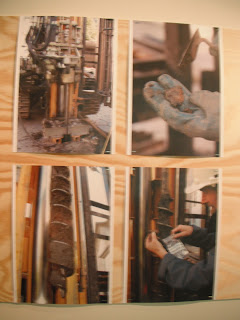Anita works in the hospital as a secretary. She took me there in the morning and I found it very interesting to get a look at a Norwegian hospital. She works in an outpatient / day surgery department. She introduced me to many of her lovely co-workers, who were very friendly to me (I wish I had taken a photo!).
My first attraction of the day was Ulriken - the highest mountain of the 7 surrounding Bergen.
The gondola takes you up to the viewing platform, which is 643 meters above sea level.
From the top of the gondola there is a panoramic view of the city, mountains, sea and fjords.
I was there first thing in the morning and I went up the gondola with a tour group full of old people. So they saw the views then went into the cafe for coffee and I continued to rock climb my way further up the mountain. It was great.. just me and the mountains!
I was a little out of my rock climbing comfort zone when I scaled down this side of the mountain. It was a bit scary, thrilling and fun!
I took videos but they don't work on the blog for some reason :/
I went to the Leprosy Museum.
They believe that Leprosy started infecting Norwegians around 1000 AD. A slow, long-lasting, fatal disease was problematic during the 13-18th centuries; the disease spread its way through Europe.
The museum was focused on how the Lepers were out casted in society. It went through the history of the leper hospitals and doctors that worked specifically with leprosy. The conditions in the hospitals were very poor, they called them the living graveyards until the 18th century. New hospitals were opened and more scientists were involved with the disease. The rate of leprosy rapidly declined in the late 1800's-1900's. In 1856 there were 2858 cases (every 2 /1000 Norwegians affected) and in 1910 there were 326 cases and the last patients infected with leprosy died in 1946.
After this museum, I walked around the old town, Bryggen.
Bryggen is a World Heritage site in the medieval quarter of Bergen.
Bryggen has been ravaged by many fires (the biggest in 1702) and it reduced the whole city to ashes. It was rebuilt on the foundations that had been there since the 11th century.
The museum is based on the findings of the archaeological excavations of Bryggen from 1955 on. The excavation provided insight into commerce, shipping, handicrafts and everyday life in medieval times.
There are now 62 protected buildings in Bryggen that rest on 10 meters of deposits formed by the remains of older, but similar buildings.
They created 30 dipp wells that document the temperature, oxygen content and groundwater levels of the deposits.
To preserve and stabilise the deposits they use the dipp wells to ensure there is no groundwater leakage and also to pump new oxygen-poor water into the deposits.
I walked through the beautiful city centre to reach the bus terminal where I headed to the airport to catch my flight to Trondheim.










No comments:
Post a Comment